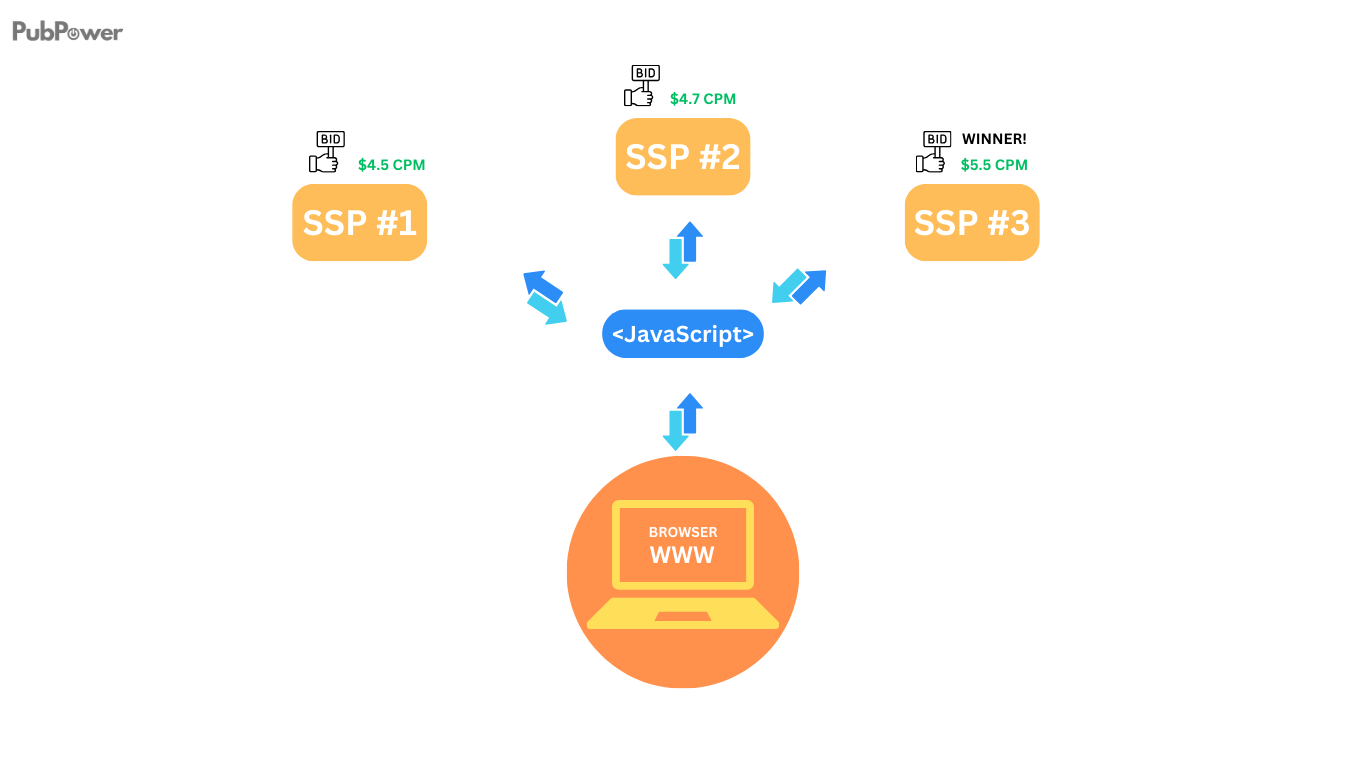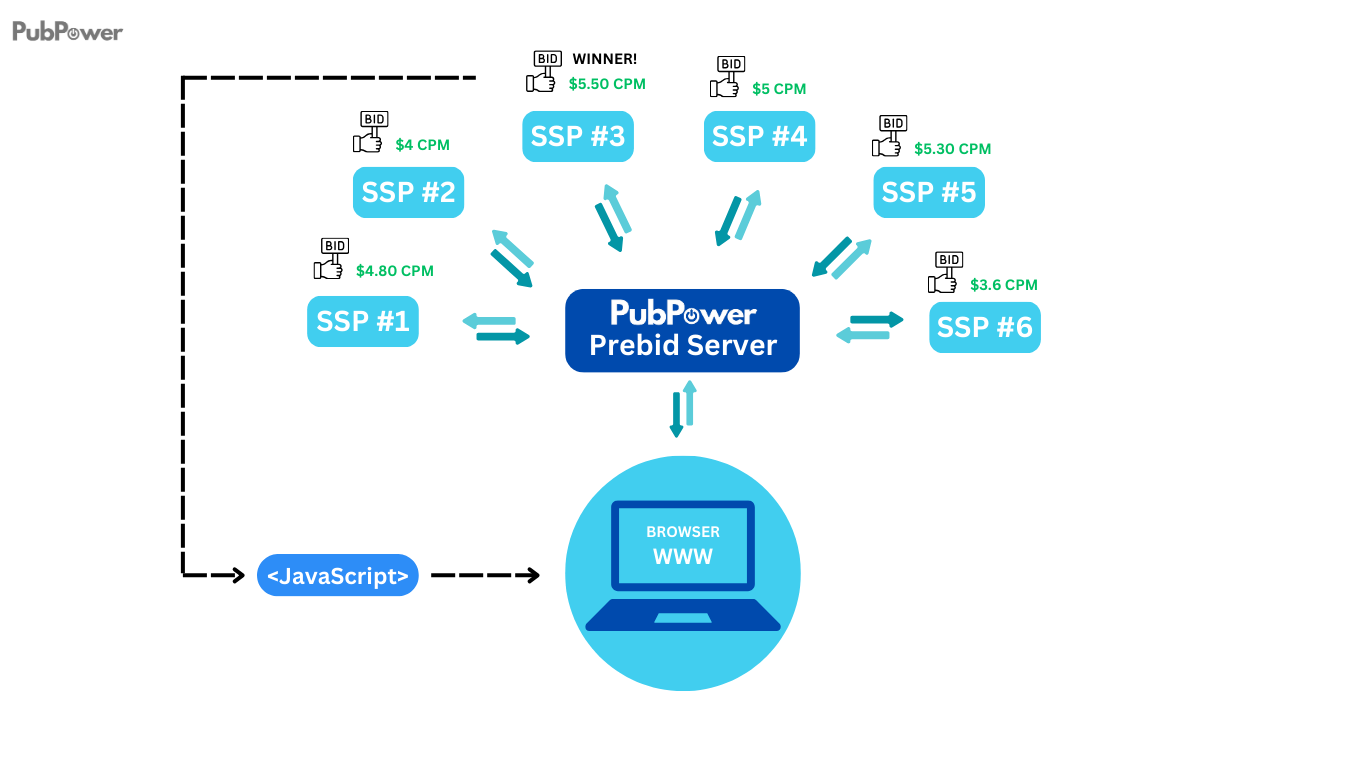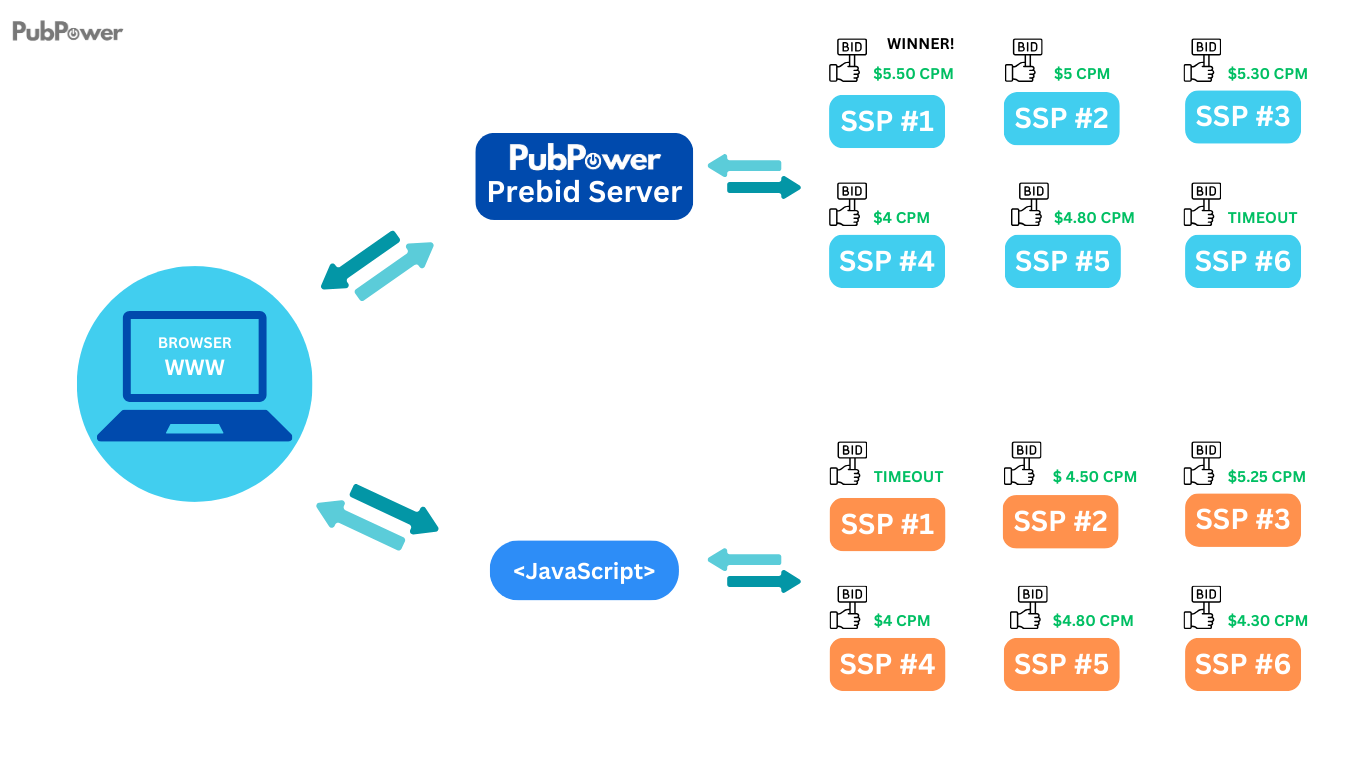Contents
Client-to-Server and Server-to-Server Header Bidding Guide
Header bidding has emerged as a pivotal strategy for publishers aiming to maximize their ad revenue. Within this domain, two distinct approaches have gained prominence: Client-to-Server (C2S) and Server-to-Server (S2S) header bidding. Each method offers unique advantages and considerations, tailored to different publisher needs and technological setups.
Client-to-Server (C2S) Header Bidding
C2S header bidding involves the integration of JavaScript tags directly within a webpage or app, allowing client devices to communicate directly with ad exchanges or demand-side platforms (DSPs).
C2S auctions function by initiating bid requests directly from the user’s browser to the server, which then sends bid requests to multiple demand partners. These partners evaluate the available ad inventory and submit bid responses back to the server with their bid prices. The server conducts an auction to determine the winning bid, considering factors like bid price and ad quality. Once the winning bid is determined, the server sends the corresponding ad creative back to the user’s browser for display on the webpage. C2S auctions offer advantages such as reduced latency and improved user experience but require robust server infrastructure to handle bid requests efficiently.

Pros:
- Greater Control: With C2S, publishers have more control over the bidding process and can fine-tune auction parameters to optimize revenue.
- Reduced Latency: By executing auctions directly within the user’s browser or app, C2S header bidding minimizes latency, leading to faster ad serving and improved user experience.
- Flexibility: Publishers can easily implement and manage C2S header bidding solutions without extensive server-side infrastructure requirements.
Cons:
- Increased Page Load Times: The inclusion of multiple JavaScript tags can impact webpage load times, potentially leading to user frustration and higher bounce rates.
- Limited Scalability: As the number of bidders increases, the complexity of managing client-side auctions can become challenging, potentially leading to operational inefficiencies.
- Privacy Concerns: C2S header bidding may raise privacy concerns due to the exposure of user data within the browser environment, leading to regulatory compliance challenges.
Server-to-Server (S2S) Header Bidding:
S2S header bidding involves the offloading of auction logic and bid requests to server-side infrastructure, reducing reliance on client devices. This might entail a particular vendor providing a paid server-to-server (S2S) header bidding service through platforms such as Prebid Server like PubPower, a favored SSP partner, or possibly even a self-managed setup if you possess the necessary server capabilities.
S2S auctions operate by facilitating bid requests and responses directly between servers, rather than involving the user’s browser. The publisher’s server sends bid requests to multiple demand partners, which evaluate the available ad inventory and submit bid responses back to the publisher’s server. The server then conducts an auction to determine the winning bid based on factors like bid price and ad quality. Once the winning bid is determined, the ad creative corresponding to the winning bid is served directly from the demand partner’s server to the publisher’s server, which then delivers it to the user’s browser for display on the webpage.
S2S auctions offer advantages such as reduced latency, increased control over auction mechanics, and improved scalability, but they require robust server infrastructure to handle bid requests and responses efficiently.

Pros:
- Improved Scalability: S2S header bidding centralizes auction logic on server infrastructure, allowing for efficient handling of a large number of bid requests and bidders.
- Reduced Latency: By shifting auction processing away from client devices, S2S header bidding can significantly reduce page load times and improve overall site performance.
- Enhanced Privacy: S2S header bidding offers greater control over user data and reduces the risk of data exposure within the client environment, addressing privacy concerns more effectively.
Cons:
- Dependency on Infrastructure: Implementing S2S header bidding requires robust server-side infrastructure, including hosting resources and maintenance overhead, which may pose challenges for smaller publishers.
- Complex Integration: Integrating S2S header bidding solutions can be more complex compared to C2S implementations, requiring coordination with multiple partners and technical expertise.
- Potential for Latency: While S2S header bidding generally reduces latency, improper infrastructure setup or network issues can still lead to delays in bid responses and ad delivery.
PubPower Header Bidding Wrapper
While monetization firms describe client-side header bidding as a header bidding wrapper solution, PubPower characterize own header bidding wrapper as a hybrid model, integrating both client-side and server-side header bidding technologies. The PubPower Header Bidding Wrapper garners the highest-value bids through client-side collection, complemented by server-side bidding. This approach ensures publishers maximize their revenue without detriment to the website’s loading speed.

Which One Should Publisher Use?
There’s no one-size-fits-all answer to whether publishers should use C2S or S2S header bidding. Therefore, PubPower hybrid header bidding wrapper is the best choice for publishers.
Conclusion
Both C2S and S2S header bidding methods offer unique advantages and challenges, catering to different publisher needs and technical requirements. Ultimately, the choice between C2S and S2S integration depends on factors such as scalability, latency sensitivity, and privacy considerations.



